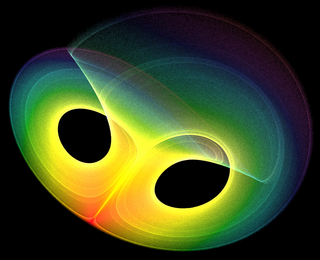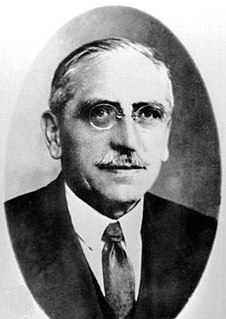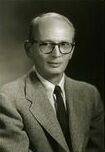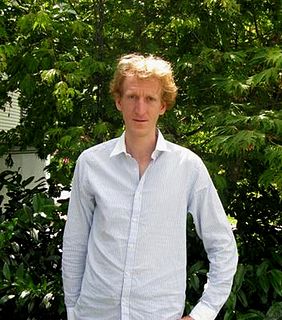
Harmonic analysis is a branch of mathematics concerned with the representation of functions or signals as the superposition of basic waves, and the study of and generalization of the notions of Fourier series and Fourier transforms. In the past two centuries, it has become a vast subject with applications in areas as diverse as number theory, representation theory, signal processing, quantum mechanics, tidal analysis and neuroscience.

The Nyquist–Shannon sampling theorem is a theorem in the field of signal processing which serves as a fundamental bridge between continuous-time signals and discrete-time signals. It establishes a sufficient condition for a sample rate that permits a discrete sequence of samples to capture all the information from a continuous-time signal of finite bandwidth.

Georg Friedrich Bernhard Riemann was a German mathematician who made contributions to analysis, number theory, and differential geometry. In the field of real analysis, he is mostly known for the first rigorous formulation of the integral, the Riemann integral, and his work on Fourier series. His contributions to complex analysis include most notably the introduction of Riemann surfaces, breaking new ground in a natural, geometric treatment of complex analysis. His famous 1859 paper on the prime-counting function, containing the original statement of the Riemann hypothesis, is regarded as one of the most influential papers in analytic number theory. Through his pioneering contributions to differential geometry, Riemann laid the foundations of the mathematics of general relativity. He is considered by many to be one of the greatest mathematicians of all time.

Analysis is the branch of mathematics dealing with limits and related theories, such as differentiation, integration, measure, infinite series, and analytic functions.

Henri Léon Lebesgue was a French mathematician known for his theory of integration, which was a generalization of the 17th-century concept of integration—summing the area between an axis and the curve of a function defined for that axis. His theory was published originally in his dissertation Intégrale, longueur, aire at the University of Nancy during 1902.

In mathematics, a Fourier transform (FT) is a mathematical transform that decomposes functions depending on space or time into functions depending on spatial or temporal frequency, such as the expression of a musical chord in terms of the volumes and frequencies of its constituent notes. The term Fourier transform refers to both the frequency domain representation and the mathematical operation that associates the frequency domain representation to a function of space or time.

Johann Peter Gustav Lejeune Dirichlet was a German mathematician who made deep contributions to number theory, and to the theory of Fourier series and other topics in mathematical analysis; he is credited with being one of the first mathematicians to give the modern formal definition of a function.
In mathematics, a positive-definite function is, depending on the context, either of two types of function.

Salomon Bochner was an American mathematician, known for work in mathematical analysis, probability theory and differential geometry.
Norman Levinson was an American mathematician. Some of his major contributions were in the study of Fourier transforms, complex analysis, non-linear differential equations, number theory, and signal processing. He worked closely with Norbert Wiener in his early career. He joined the faculty of the Massachusetts Institute of Technology in 1937. In 1954, he was awarded the Bôcher Memorial Prize of the American Mathematical Society and in 1971 the Chauvenet Prize of the Mathematical Association of America for his paper A Motivated Account of an Elementary Proof of the Prime Number Theorem. In 1974 he published a paper proving that more than a third of the zeros of the Riemann zeta function lie on the critical line, a result later improved to two fifths by Conrey.

Joseph Leo "Joe" Doob was an American mathematician, specializing in analysis and probability theory.

Lennart Axel Edvard Carleson is a Swedish mathematician, known as a leader in the field of harmonic analysis. One of his most noted accomplishments is his proof of Lusin's conjecture. He was awarded the Abel Prize in 2006 for "his profound and seminal contributions to harmonic analsysi and the theory of smooth dynamical systems."

Ben Joseph Green FRS is a British mathematician, specialising in combinatorics and number theory. He is the Waynflete Professor of Pure Mathematics at the University of Oxford.
In applied mathematics, the Wiener–Khinchin theorem, also known as the Wiener–Khintchine theorem and sometimes as the Wiener–Khinchin–Einstein theorem or the Khinchin–Kolmogorov theorem, states that the autocorrelation function of a wide-sense-stationary random process has a spectral decomposition given by the power spectrum of that process.
In complex analysis, a subfield of mathematics, a lacunary value or gap of a complex-valued function defined on a subset of the complex plane is a complex number which is not in the image of the function.
In analysis, a lacunary function, also known as a lacunary series, is an analytic function that cannot be analytically continued anywhere outside the radius of convergence within which it is defined by a power series. The word lacunary is derived from lacuna, meaning gap, or vacancy.
In mathematics, the Ostrowski–Hadamard gap theorem is a result about the analytic continuation of complex power series whose non-zero terms are of orders that have a suitable "gap" between them. Such a power series is "badly behaved" in the sense that it cannot be extended to be an analytic function anywhere on the boundary of its disc of convergence. The result is named after the mathematicians Alexander Ostrowski and Jacques Hadamard.
In mathematics, the Fabry gap theorem is a result about the analytic continuation of complex power series whose non-zero terms are of orders that have a certain "gap" between them. Such a power series is "badly behaved" in the sense that it cannot be extended to be an analytic function anywhere on the boundary of its disc of convergence.
Daniel Gisriel Rider, Jr. was a mathematician, specializing in harmonic analysis and Fourier analysis.










